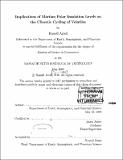Implications of Martian polar insolation levels on the climatic cycling of volatiles
Author(s)
Arrell, Russell, 1975-
DownloadFull printable version (10.03Mb)
Other Contributors
Massachusetts Institute of Technology. Dept. of Earth, Atmospheric, and Planetary Sciences.
Advisor
Maria Zuber.
Terms of use
Metadata
Show full item recordAbstract
Solar insolation at the poles is the driving force in Mars' seasonal climatic cycle. Mars' obliquity has varied greatly in the geologically recent past and this would have had a profound effect on the past climate. Previous studies have always assumed a spherical planet when calculating insolation. This study uses a geodetic elevation model (GEM) of the elevation data from the Mars Orbiter Laser Altimeter, to provide accurate insolation calculations. This method takes into account the long and shortwavelength topography, the planetary curvature, and the planetary flattening. This paper outlines the design and implementation of a GEM, and presents insolation calculations for Mar's north polar cap for obliquities of 150, 250 and 450. This study found that the elevation of the northern ice cap above the surroundings results in the ice cap having more days of sunlight than previously thought.
Description
Thesis (S.M.)--Massachusetts Institute of Technology, Dept. of Earth, Atmospheric, and Planetary Sciences, 2000. Includes bibliographical references (leaves 35-36).
Date issued
2000Department
Massachusetts Institute of Technology. Department of Earth, Atmospheric, and Planetary SciencesPublisher
Massachusetts Institute of Technology
Keywords
Earth, Atmospheric, and Planetary Sciences.